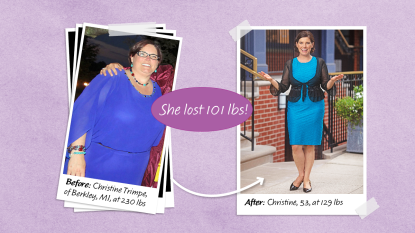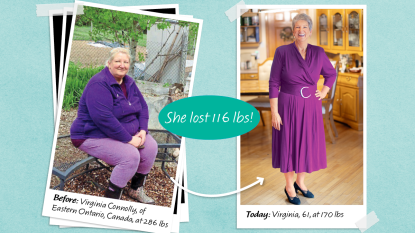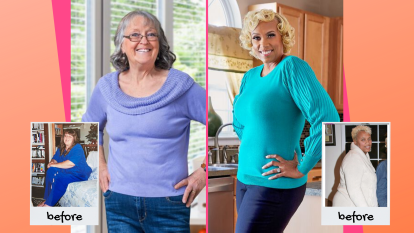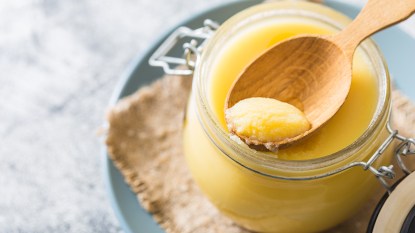The Research Is Overwhelming: Eat *This* Much Fiber Per Day to Automatically Lose Weight — No Diet Required
It worked for Michele Malkowiak, who lost 122 lbs and wore a bikini for the first time at age 55!
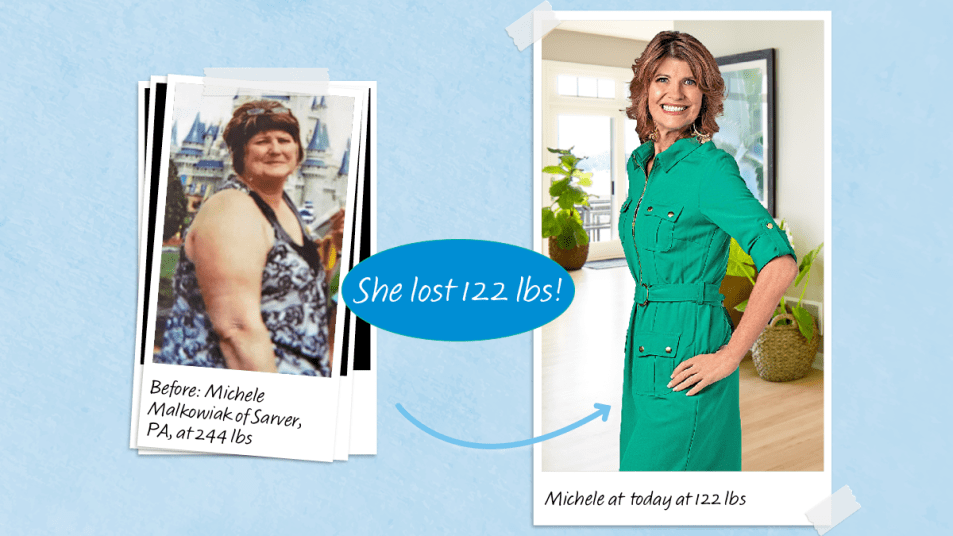
When you’re trying to lose weight, choosing the right foods to eat can be more than confusing. With so much information out there about what’s good for you and what’s not good for you — or what you should focus on and what you should steer clear of — it’s hard to know exactly which nutrition path to follow. Thankfully, one of the easiest and most affordable nutrition choices you can make to impact your overall health and weight is as simple as eating more fiber. That’s it. Just reaching for fiber-rich apples, raspberries, pistachios, bread or quinoa can unlock an amazing transformation. Read on to learn how much fiber you should aim for to lose weight and then be inspired by one woman who dropped 122 lbs thanks to increasing her consumption of high-fiber foods.
What is fiber and why do we need more of it?
Fiber is a unique type of carbohydrate that the body can’t absorb but is desperately needed to improve digestion, curb hunger and speed weight loss. Despite its importance, up to 97% of Americans are deficient in fiber, says ob-gyn Mary Claire Haver, MD, author of The Galveston Diet. Two reasons for the deficiency: First, we’re simply eating fewer whole foods in our busy, grab-and-go schedules. Secondly, modern food processing routinely strips away the nutrient dense fiber from grains to improve their shelf life in stores. That’s concerning since the Grain Foods Foundation reports that nearly 40% of dietary fiber that Americans get comes from grain foods. (Click through to learn more about how wheat germ is helping women over 45 lose weight.)
Just how bad is this nutrition deficiency? “The average person is getting only 5 to 14 grams of fiber per day,” notes health expert JJ Virgin, who teaches doctors how to counsel patients about proper nutrition. That falls well below the recommended daily intake for fiber, which is at least 25 grams for women and 30 to 35 grams for men. (Click through to our sister publication see how fiber can improve kidney function naturally.)
How much fiber you need to lose weight
Despite recommended daily allowances, there’s been some debate as to how much fiber you really need to eat if you want to lose weight. Many experts agree that around 25 grams per day is best. But a study published in the journal ISRN Obesity found the magic number that could help you lose up to a pound each week should be nudged up to 28 grams of fiber per day. In that study, a group of subjects were instructed to increase their fiber intake by 12 grams per day, up to the amount of 28 grams. To do so, the test group either added a cup and a half of beans or high-fiber foods like vegetables, fruits and whole grains to their diets each day. The result: Study participants reported feeling more satisfied with less hunger and cravings throughout the day. Plus, by the end of the study, the test group lost between three and four pounds — just about a pound a week.
The upper limit for fiber intake continues to be pushed and explored as scientists learn more about how fiber can assist the body. Additional research suggests getting 35 grams can boost its anti-aging benefits. That’s why Dr. Haver recommends up 35 grams of fiber per day. As for Virgin, whose plan The Virgin Diet helps women drop seven pounds in seven days, she encourages everyone to aim for up to a whopping 50 grams of fiber per day.
Related: Getting More Dietary Fiber Can Work Better For Some Women Than Antidepressants
The importance of increasing fiber slowly
As much as we can benefit from getting more fiber in our diets, all experts caution against jumping into a fiber-rich diet overnight. Instead, they encourage slowly building up to a higher amount of fiber. The reason: Eating too much fiber too quickly can result in uncomfortable symptoms such as gas, bloating, constipation and cramping.
Digestion expert Vincent Pedre, MD, author of The GutSMART Protocol, recommends gradually building up your fiber levels over time: Increasing your intake by 5 grams a day and then monitor your GI symptoms. When you can handle the amount of fiber without side effects then increase another 5 grams and so on. While doing so, it’s important to drink more water. Water is key here since the fluid will help your body handle all that fiber and prevent constipation. (Click through to discover how a motivational water bottle can help you increase your daily water intake.)
How fiber promotes weight loss
Once you’ve comfortably increased your fiber intake, healthy weight loss is very likely to follow automatically, according the experts who we spoke with. And the ISRN Obesity study isn’t the only one that shows dietary fiber can assist with weight loss: It’s been found that eating a high fiber diet prevents metabolic conditions like obesity and type 2 diabetes.
Fiber can speed weight loss in many ways. It helps keep bowel movements healthy and regular, which is crucial on any weight loss journey. In addition, it plays a role in helping you feel satiated, and since it feeds the good bacteria in your gut, it’s also said to improve immunity, prevent disease, lower inflammation and even support good mental health.
How to get more fiber in your diet
Luckily, adding more fiber to your diet can be both simple and inexpensive. There are study-proven methods like eating a cup and a half of beans with lunch or dinner each day. (Click through for an easy tip to stop beans from making you gassy.) Also smart: Choosing other high-fiber foods like berries, mangos, kiwis, apples, nuts and nut butters, broccoli, green leafy vegetables, sweet potatoes, artichokes, carrots, beets and whole grains. If these kinds of whole foods seem bland, click through for healthy high-fiber snacks.
Related: Sweet Potatoes Help Tame Menopausal Hot Flashes, Mood Swings & Vaginal Dryness
Reach for a variety of forms of fiber
Fiber comes in different forms that each work differently in the body. There’s insoluble fiber, which doesn’t dissolve in water and stays intact to aid in digestive regularity. Think of whole grains, nuts, seeds and fresh produce. Then there’s soluble fiber, which dissolves in water to form a gel-like substance to make you feel fuller longer. Think of how oats or chia seeds swell and gel in water. (For more, check out this article on how soluble fiber helps with weight loss.)
There are also lesser-known forms of fiber including resistant starch, a special type that delays, or resists, being digested until after it passes through the small intestine. It is found in barely ripe bananas and sushi rice that has been cooked and cooled.
Lastly, there is also prebiotic fiber, a form of fiber that is seen as “food” for healthy bacteria living in our gut and improving our digestive health. It’s found in plenty of foods like berries, garlic and chickpeas. This type of fiber doesn’t just help with weight loss, it actually prevents damage to the gut lining that can trigger all sorts of problems like inflammation and poor immunity.
Eating a variety of fiber is so effective at controlling appetite, it can take the effort and struggle out of any diet attempt. World-famous nutrition expert Neal Barnard, MD, says, “I encourage people to have a non-willpower diet, one that lets the foods do the work for you. High fiber foods, high water foods, plant based foods in general, they do the work for you, muscling the weight off.” (Click through to learn more about the different types of fiber you need in your diet.)
How to get the benefits of fiber
Here are four smart ways to add fiber to your diet to get the most benefit:
Eat fiber first at mealtime. “When eaten at the beginning of a meal, fiber significantly reduces the glucose spike of any food that follows,” explains blood-sugar expert Jessie Inchauspe. How exactly? “As fiber arrives in our intestines, it deploys itself against our intestinal wall, forming a protective mesh that slows and reduces the absorption into the bloodstream of any glucose coming down afterward.” The result: Fewer blood-sugar spikes means fewer cravings that pack on unwanted pounds. So before any carb-rich meal like pasta, first eat a veggie appetizer like 1 cup of spinach, which delivers 4 grams of protective fiber.
Pair fiber with protein during snacks. “Protein and fiber is the single best combination you can eat,” contends nutrition scientist Paul Arciero, PhD. He likes the idea of adding a plant-based protein powder to fiber-rich oatmeal muffins or cookies. He explains, “You increase your metabolism by transitioning your body from being a carbohydrate burner to becoming a fat burner. We call that metabolic flexibility.”
Snack on prunes. These easy, on-the-go snacks are packed with fiber — 3 grams in every 4 prunes. Even better, the fruits are also proven to strengthen bones. Penn State researchers found that a daily dose of prunes prevented loss of bone density in postmenopausal women. And eating five prunes a day enhanced new bone formation — a benefit that reduces the risk of brittle bones by 50%.
Mix hemp protein into smoothies. If you’re looking for a protein powder that is rich in fiber, consider hemp seed powder, where each ¼ cup delivers 8 grams of fiber. That explains why hemp has been found to help you feel fuller, plus lower post-meal blood-glucose levels, two factors that benefit weight loss. And as a bonus, hemp contains omega-3 fats that improve mood and slash the risk of anxiety and depression.
Fiber worked for Michelle — she lost 122 lbs!
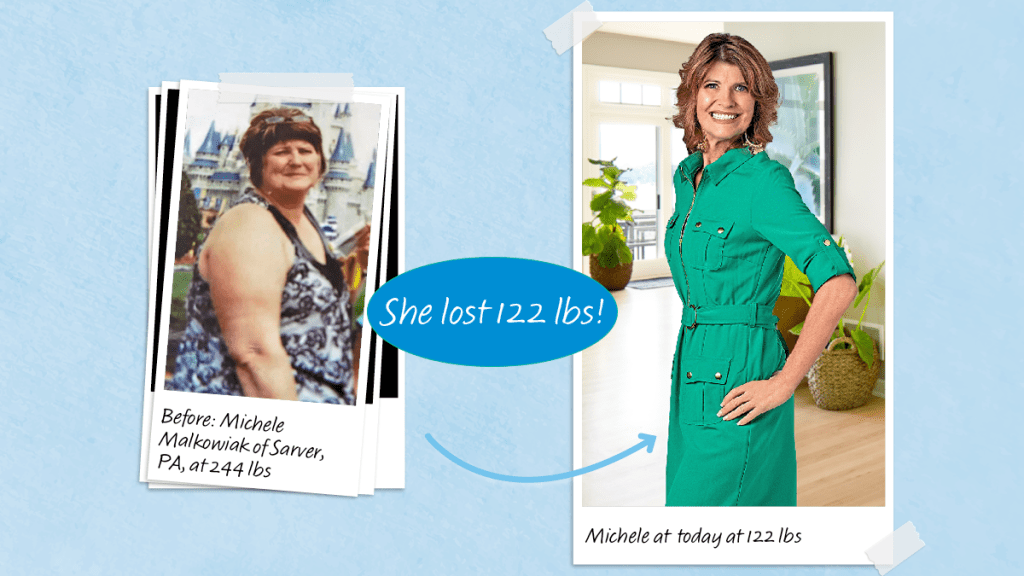
Michele Malkowiak had her wake-up moment during the pandemic when she realized all the extra pounds on her body were putting her at risk for severe COVID-19 complications if she got the virus. That’s when she decided: If I’m stuck at home, I might as well focus on losing weight.
So Michele started making healthy changes: drinking more water, walking in her neighborhood for exercise and adding lots of satisfying fiber to her diet. She made sure to sneak some fiber into every meal and consume different types. She noshed on apples, oatmeal, green peppers and onions for soluble fiber; popcorn, whole-grain pasta, bread and shredded wheat cereal for insoluble fiber; and sweet potatoes for resistant starch.
Michele began seeing steady weight loss on the scale. Best of all, this healthy-eating approach didn’t cramp her style—she could still order from restaurants, enjoy carbs and eat dessert while slimming. It was so easy, she was able to eat fiber every day of her weight loss.
“Fiber became super important to me,” says Michele, who also found accountability by weighing in weekly at her local TOPS.org (Take Off Pounds Sensibly) chapter.
In total, Michele lost half her body weight and traded her “before” size of 22 for a size 2 in a little more than 12 months. Now, she’s enjoying more energy, better mobility and improved immunity. “I’m 55 years old and I can wear a bikini for the first time,” she cheers. “My life has changed so much for the better!”
For more on how fiber can help power off the pounds:
Can Wheat Germ Help Women Over 45 Lose Weight? New Evidence Says ‘Yes!’
The Keto Fiber Secret That’s Helping Women Lose 5 Times More Weight
A version of this article originally appeared in our print magazine, First for Women.
This content is not a substitute for professional medical advice or diagnosis. Always consult your physician before pursuing any treatment plan.
Lisa Maxbauer is an award-winning health and nutrition writer at First for Women and Woman’s World magazines. She is a former guest blogger with The New York Times and author of the award-winning independent children’s book Squash Boom Beet. Learn more at SquashBoomBeet.com and follow on Instagram @lisamaxbauer.
Taylor Patton is a Milwaukee-based writer, editor and professional storyteller. Published in ‘Milwaukee Magazine,’ ‘Edible Milwaukee,’ ‘Woman’s World’ and ‘First for Women,’ she loves finding everyday stories that are just begging to be told. As a certified RYT-200 yoga teacher and vegetarian for 15 years, she believes everyone can eat, drink and live a little more green.





